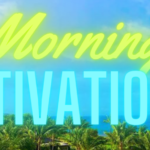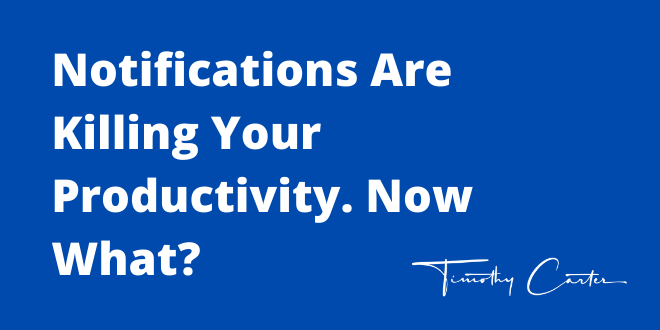
Unleash Your Potential: The Power of Language
March 1, 2024
Take Charge: You’re the Boss
March 2, 2024How often do you receive notifications throughout the day? Think of everything from new text message notifications and phone calls to the chimes that sound whenever a new email comes in. If you’re like most entrepreneurs, you’re being bombarded with notifications, and whether you realize it yet or not, it’s killing your productivity.
Why notifications are so problematic
Notifications are an issue for a few major reasons. Most notably, they serve as a distraction. Whether it’s the popup of a red number on your favorite app, a vibration or a sound notification, these alerts are designed to get your attention. They’re practically impossible to ignore. If you’re working on something important, your focus is going to drift, and your effectiveness will immediately decline. Some studies suggest it takes a full 23 minutes to recover your focus after a distraction, meaning each new notification could be compromising your full focus for up to 23 minutes.
Of course, these temporary distractions are just the beginning. Oftentimes, notifications are a call to some other time-stealing requirement. For example, one of your employees might send you an instant chat message asking you a few questions about a project; once this gets your attention, you’ll feel compelled to write out an answer.
Notifications can also be somewhat addictive. Social media apps, for example, design themselves to produce dopamine releases like slot machines, conditioning us to anticipate notifications so much that we feel phantom notifications at random intervals. We might even feel anxiety or very mild withdrawal-like symptoms if we go too long without notifications.
These issues wouldn’t be so problematic if it weren’t for three important compounding factors, which exacerbate these negative effects:
- Notifications are everywhere. Software developers have figured out that notifications tend to keep people using their products. Accordingly, notifications are pervasive. It’s not just emails, text messages and phone calls that trigger alerts these days. You’ll receive notifications about automatic bill payments, project management system updates and even social media activity.
- Notifications are on by default. Making matters worse, notifications are almost always turned on by default, and notifications are “normal” in our work culture. Every new app you download will try to start sending you notifications immediately, and throughout your office, you likely hear a cascade of notification sounds throughout the day.
- We underestimate the power of notifications. Notifications were initially conceived as a way to make us more attentive and more productive; after all, there’s value in knowing exactly when you receive a new email, rather than checking your email manually at predefined intervals. Accordingly, we assume that notifications “can’t be that bad.”
Because of this, most of us have become slaves to the call of notifications, and our productivity is suffering as a result.
How to eliminate the negative effects of notifications
Here’s a bold idea: Turn off notifications for everything. This is the obvious solution that none of us actually want to consider. We might be slightly deterred by the manual effort required to hunt down and change settings for dozens of apps and services, but it’s more likely that we’re deterred by fear. We’re afraid of missing an important notification when we need it most.
So how can we assuage this fear while still improving control over our notification bombardment?
There are a few more manageable solutions:
- Manage the notifications you receive. First, consider changing which notifications you receive and when. For example, on a project management platform, you may be able to turn off notifications for “all new updates” and only receive notifications when your name is tagged. You can also turn off notifications for unimportant apps, like social media apps or web notifications, and leave them on for things like email.
- Toggle between focused and open hours (or days). Alternatively, you could leave notifications off for predefined periods of time. For example, you can turn off notifications from 2-3 pm each day and designate this as “heads-down” time, notifying your team that you’re unavailable during these periods. You could even take an entire day each week to work notification-free.
- Reserve a channel for emergencies. If turning off notifications makes you feel anxious, consider opening a reserved channel for emergencies, like a chat platform or SMS text messages on your phone. Turn off notifications for everything except this emergency channel, so you can rest easy knowing everything else can wait.
Notifications don’t seem like a big deal, but in sufficient volume, they can sabotage your productivity. If you don’t do anything and let notifications rule your working life, it’s going to work against you. Come up with a strategy that allows you to minimize the number of notifications you receive while still giving you the communicative access you need.
FAQ Section: Managing Notifications for Improved Productivity
1. How do notifications impact cognitive load and mental fatigue, and are there strategies for mitigating these effects beyond simply managing notification settings?
Notifications can significantly increase cognitive load by interrupting ongoing tasks and demanding attention. Each notification disrupts the flow of concentration, forcing the brain to switch focus from the task at hand to the incoming alert. This cognitive switching incurs a cost known as “switching cost,” where the brain must expend mental resources to disengage from one task and re-engage with another. Over time, frequent interruptions from notifications can lead to mental fatigue, reducing productivity and impairing cognitive performance.
To mitigate the impact of notifications on cognitive load and mental fatigue, individuals can employ several strategies beyond simply managing notification settings:
- Batching: Instead of allowing notifications to arrive continuously throughout the day, schedule specific times to check and respond to messages and alerts. Batching allows individuals to allocate dedicated periods for communication tasks, minimizing interruptions and preserving focus during other tasks.
- Priority Filtering: Prioritize notifications based on importance and relevance. Configure notification settings to filter out non-urgent or low-priority alerts, ensuring that only critical notifications reach you immediately. This approach reduces the overall volume of interruptions while ensuring that important information doesn’t go unnoticed.
- Mindfulness Practices: Incorporate mindfulness techniques into daily routines to cultivate awareness and resilience against distractions. Techniques such as deep breathing, meditation, or mindfulness exercises can help individuals maintain focus and manage stress when confronted with disruptive notifications.
- Single-Tasking: Emphasize single-tasking over multitasking to minimize cognitive overload. Focus on completing one task at a time without succumbing to the temptation of switching between multiple activities. By dedicating full attention to each task sequentially, individuals can improve efficiency and reduce the negative impact of interruptions.
2. Are there any long-term consequences of chronic exposure to high volumes of notifications, such as effects on attention span, stress levels, or overall mental health?
Chronic exposure to high volumes of notifications can have significant long-term consequences on various aspects of mental health and cognitive functioning. Some potential effects include:
- Reduced Attention Span: Constant exposure to notifications can lead to attentional fatigue and diminished cognitive control over time. Individuals may experience difficulty sustaining focus on tasks, increased distractibility, and impaired ability to filter irrelevant information from the environment.
- Elevated Stress Levels: Frequent interruptions from notifications can trigger stress responses in the body, leading to heightened levels of cortisol and other stress hormones. Prolonged exposure to stress may contribute to burnout, fatigue, and feelings of overwhelm, negatively impacting overall well-being.
- Impaired Memory and Learning: Interruptions disrupt the encoding and consolidation of information in working memory, impairing learning and memory recall processes. Over time, repeated interruptions can hinder cognitive performance and inhibit the acquisition of new knowledge and skills.
- Sleep Disturbances: Excessive notification exposure, particularly before bedtime, can disrupt sleep patterns and impair sleep quality. The blue light emitted by electronic devices, coupled with the anticipation of incoming notifications, can interfere with the onset of sleep and reduce overall sleep duration.
To mitigate the long-term consequences of notification overload, individuals should adopt proactive strategies to manage their digital environment, establish boundaries around technology use, and prioritize self-care practices to promote mental and emotional well-being.
3. What role do individual differences, such as personality traits or work habits, play in how people perceive and respond to notifications, and how can individuals tailor their notification management strategies accordingly?
Individual differences, including personality traits, cognitive styles, and work habits, can significantly influence how people perceive and respond to notifications. Some key factors to consider include:
- Personality Traits: Individuals with different personality traits may have varying tolerance levels for distractions and interruptions. For example, introverted individuals may find constant notifications more intrusive and draining than extroverted individuals. Tailoring notification management strategies to align with one’s personality preferences can help minimize stress and enhance productivity.
- Cognitive Styles: Cognitive differences, such as attentional control and working memory capacity, can shape how individuals process and manage incoming notifications. Those with strong attentional control may be better equipped to filter out irrelevant alerts and maintain focus on priority tasks. Understanding one’s cognitive strengths and weaknesses can inform personalized approaches to notification management.
- Work Habits: Work environments and routines can influence how individuals integrate technology into their workflow and interact with notifications. For instance, individuals in fast-paced, deadline-driven professions may prioritize responsiveness to incoming messages, while those in more autonomous roles may prefer uninterrupted blocks of focused work. Adapting notification strategies to accommodate specific work contexts and preferences can optimize efficiency and job satisfaction.
By recognizing and accommodating individual differences, individuals can tailor their notification management strategies to align with their unique needs, preferences, and professional responsibilities. Experimenting with different approaches and soliciting feedback from colleagues or mentors can help individuals identify the most effective strategies for minimizing distractions and maximizing productivity.





